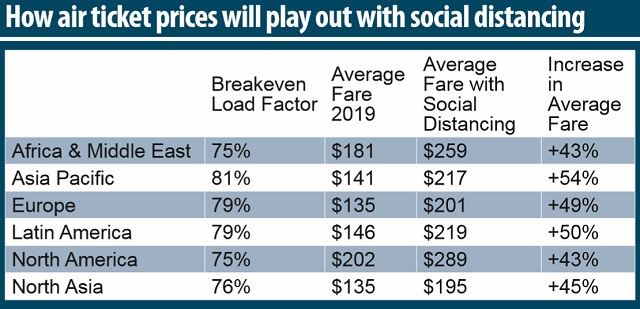
Airlines say social distancing onboard could mean high costs for passenger air transport
Kampala, Uganda | ISAAC KHISA | International Air Transport Association has warned that air ticket prices could rise up to 54% depending on the region if airlines are forced to exercise social distancing onboard due to the ravaging coronavirus pandemic, according to its Director General and CEO, Alexandre de Juniac.
Juniac said in a statement that airlines supports wearing of face coverings for passengers and masks for crew while on board aircraft as a critical part of a layered approach to biosecurity to be implemented temporarily when people return to traveling by air, but do not support mandating social distancing measures that would leave ‘middle seats’ empty.
“Airlines are fighting for their survival. Eliminating the middle seat will raise costs. If that can be offset with higher fares, the era of affordable travel will come to an end,” he said.
On the other hand, if airlines can’t recoup the costs in higher fares, airlines will go bust. Neither is a good option when the world will need strong connectivity to help kick-start the recovery from COVID-19’s economic devastation.”
This is in response to the European Commission’s recent announcement that it would release a set of rules this month requiring airlines to exercise social distancing in airports and onboard the aircrafts.
Though African countries are yet to announce new measures as airlines plan to take off to the skies again, the EU’s step, if implemented, could also hurt African carriers that flies to Europe including Ethiopian airlines, Kenya Airways, Royal Air Maroc, South African Airways and RwandAir.
The step, however, could also cascade to other countries including in African hurting various airlines such as the newly unveiled Uganda Airlines.
Juniac said evidence suggests that the risk of transmission on board aircraft is low and that mask-wearing by passengers and crew will reduce the already low risk, while avoiding the dramatic cost increases to air travel that onboard social distancing measures would bring.
“The safety of passengers and crew is paramount. The aviation industry is working with governments to re-start flying when this can be done safely. Evidence suggests that the risk of transmission on board aircraft is low,’ he said.
“And we will take measures—such as the wearing of face coverings by passengers and masks by crew—to add extra layers of protection. We must arrive at a solution that gives passengers the confidence to fly and keeps the cost of flying affordable. One without the other will have no lasting benefit.”
Moreover, even if mandated, keeping the ‘middle seat’ open will not achieve the recommended separation for social distancing to be effective, Juniac said, adding that most authorities recommend 1m-2m while the average seat width is less than 50 cm.
He said the cabin environment naturally makes transmission of viruses difficult for a variety of reasons and that that helps explain why they have seen little occurrence of onboard transmission.
He said other measures that airlines will undertake include; temperature screening of passengers, airport workers and travelers, boarding and deplaning processes that reduce contact with other passengers or crew, limiting movement within the cabin during flight, frequent and deeper cabin cleaning; and simplified catering procedures that lower crew movement and interaction with passengers.
Long term solutions
He said long term solutions for COVID-19 depend on medical science.
“We need a vaccine, an immunity passport or an effective COVID-19 test that can be administered at scale. Work on all of these is promising,” he said, ‘but none will be realized before we will need to re-start the industry.”
However, some U.S. airlines have already implemented their own measures including blocking middle seats, pausing automatic upgrades and changing the boarding process. In Canada, regulators started requiring passengers to wear a non-medical mask or face covering during the boarding process and flights.

****
CLICK TO READ ONLINE MAGAZINE HERE
 The Independent Uganda: You get the Truth we Pay the Price
The Independent Uganda: You get the Truth we Pay the Price


